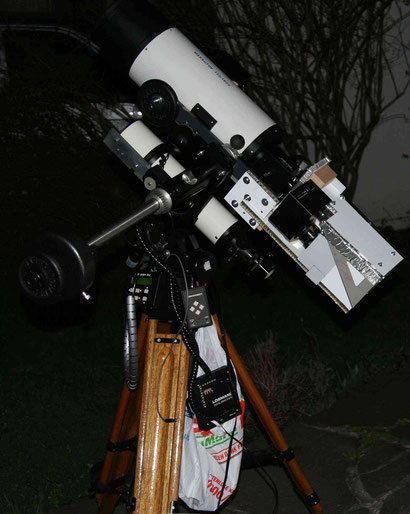Slitless Prism Spectrograph
My first experiments in DIY spectrography used a cheap 60degree F2 prism (from Surplus Shed)
mounted on a rotatable Cokin filter holder. The Cokin filter holder was attached to a DSRL lens in front of the CCD camera. This setup and results have been described here <> (in German).
Around this rotatable prism/lens/camera assembly a spectrometer was built, using a camera lens to collimate the light beam from the telescope. A manually adjustable slit (from Surplus Shed) was placed in the telescope focus, to enable spectral calibration on a lamp or on the skylight.
The slit was opened for stellar observations (the slit was not reflective and there was no slit guiding). Guiding was done using an external 80mm guidescope.
The large deviation angle from the prism enables an arrangement where the camera optical axis is parallel to the collimator optical axis. This requires minimal space and places the weight of the camera close to the telescope.
The spectrometer box was constructed from ALUCORE, a very lightweight yet stiff aluminium honeycomb sandwich.
A similar box design is now used in the SMAGS spectrograph, the design is described more in detail here.

Figure: The prism spectrograph.
Light enters from lower right through the adjustable slit (adjusting knob to the right of the collimator lens), then through the collimating lens (Vivitar 200mm/F4 or Olympus 135mm/F3.5, exchangable), via the adjustable flat mirror at right to the prism (visible just above the nose of the collimator). The black box at upper right is the camera.

Figure: Prism Spectrograph behind telescope.
The telescope is a MK-66 Maksutov from INTES (now STF) with 15cm aperture and 1800mm focal length.
The mount is a Losmandy GM-8 with digital setting circles. Autoguiding can be done with a separate guidescope, using a Moravian Instruments G-300 guiding camera with Starlight-Express relay box to interface to the GM-8

The spectrograph is attached to a flip-mirror, so that the measurement star can be placed on the (opened) slit. The spectrograph is attached to a flip-mirror, so that the measurement star can be placed on the (opened) slit.
A second attachment point is fixed to the dovetail of the telescope, because the connection to the flip mirror alone cannot take the spectroscope weight (~4 kg).
 This Site is slowly but continuously improved :-)
This Site is slowly but continuously improved :-)